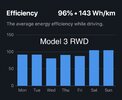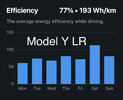30,000 mile (48,000 km) update for my Sep 2021 SR+ LFP. The car is now 12 months old and was originally rated at 253 miles on a full charge. The Tessie app shows a battery capacity of 52.6 kWh (down 3.7% from my original 23 Oct 2021 post of 54.6 kWh), and a max range of 243 miles (down 4.0% from my original range of 253 miles). I've had Tessie since my first day or two or ownership, so this data shows the entire life of the car.
View attachment 853550
According to the car's screen, I'm now averaging 214 Wh/mi over the life of the car (down from 217 at the 25,000 mile update). Seasonal temps and driving style are HUGE when it comes to the car's efficiency. In the winter I can expect 240+ Wh/mi, and in ideal temps (75-85f) I routinely manage under 200 Wh/mi on my 100 mile roundtrip commute (you can see my summertime average is currently 202 Wh/mi). Assuming I could tap into the current 52.6 kWh battery at my lifetime average 214 Wh/mi efficiency, that gives me a real-world range of 245.7 miles.
View attachment 853552
My charging is mostly Level 2 from a Grizzl-E set to delivery 24 amps on a 40 amp circuit in my garage. I charge most nights due to a long commute, typically to about 70-80% a few times per week and a 100% once or twice a week. I do fast charge about once per week on average due to a side gig that requires long days of weekend deliveries...the CCS adapter has been a huge improvement for this, greatly expanding my charging options during these deliveries and saving me lots of time in the process.
Tessie says I've spent $830.37 on electricity for the life of the car, while the same driving in my old Ford Focus would've cost $2,939.19 in gasoline. So my fuel costs have been 28% compared to keeping my old car. Assuming the average US emissions of 0.85 pounds CO2 per kWh, the 6,428 kWh used while driving equates to 5,463 pounds of CO2 spent driving my Tesla. If I'd kept my 2012 Ford Focus (37mpg), I would've used 811 gallons of gas to travel these 30,007 miles. At about 19 pounds of CO2 per gallon, that would've been 15,409 pounds of CO2. So I'm spewing 35% of the carbon emissions than I would've released in my efficient little Focus. As the grid moves toward more renewables, that should only get better over the life of the car. Also, my Focus would've had 220,000 miles on it now, so I'd probably be forced to replace it soon anyway.
View attachment 853553
I'll try to post another update at 35,000 miles. We should be into cold weather by then, so my efficiency will be taking a hit.




